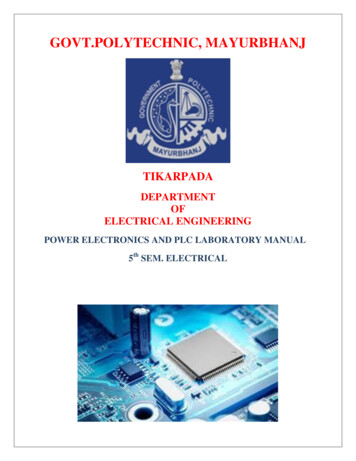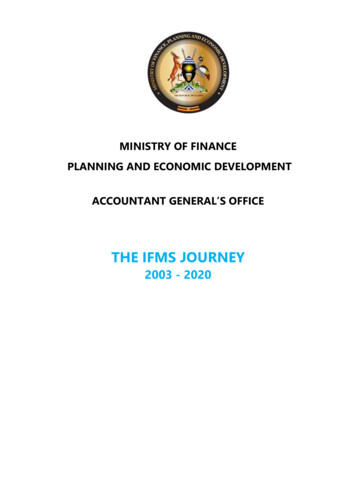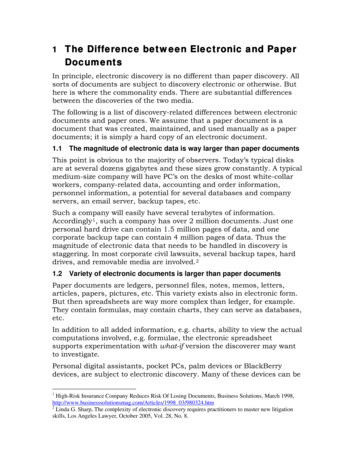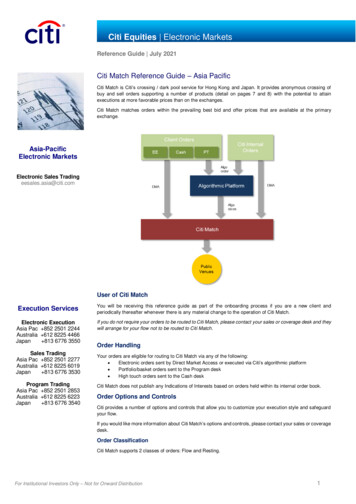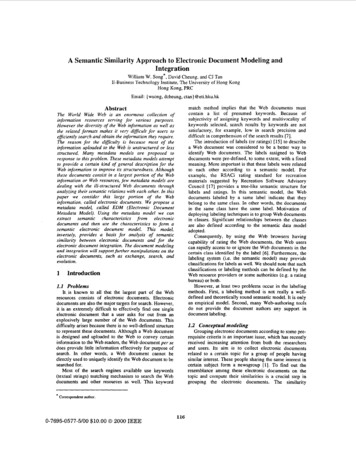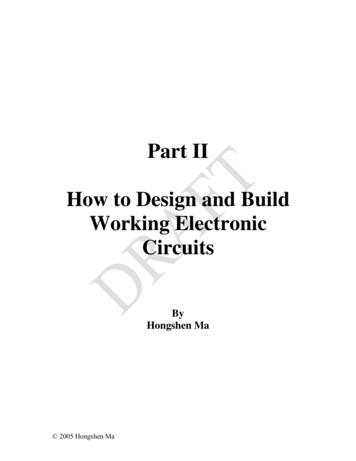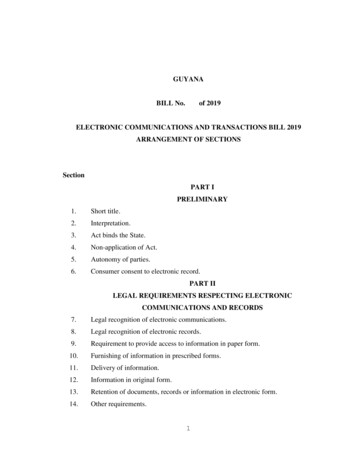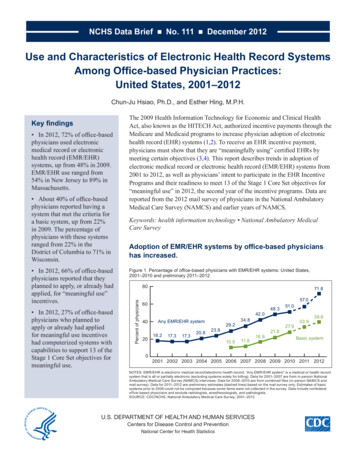
Transcription
NCHS Data Brief No. 111 December 2012Use and Characteristics of Electronic Health Record SystemsAmong Office-based Physician Practices:United States, 2001–2012Chun-Ju Hsiao, Ph.D., and Esther Hing, M.P.H. In 2012, 72% of office-basedphysicians used electronicmedical record or electronichealth record (EMR/EHR)systems, up from 48% in 2009.EMR/EHR use ranged from54% in New Jersey to 89% inMassachusetts. About 40% of office-basedphysicians reported having asystem that met the criteria fora basic system, up from 22%in 2009. The percentage ofphysicians with these systemsranged from 22% in theDistrict of Columbia to 71% inWisconsin. In 2012, 66% of office-basedphysicians reported that theyplanned to apply, or already hadapplied, for “meaningful use”incentives. In 2012, 27% of office-basedphysicians who planned toapply or already had appliedfor meaningful use incentiveshad computerized systems withcapabilities to support 13 of theStage 1 Core Set objectives formeaningful use.The 2009 Health Information Technology for Economic and Clinical HealthAct, also known as the HITECH Act, authorized incentive payments through theMedicare and Medicaid programs to increase physician adoption of electronichealth record (EHR) systems (1,2). To receive an EHR incentive payment,physicians must show that they are “meaningfully using” certified EHRs bymeeting certain objectives (3,4). This report describes trends in adoption ofelectronic medical record or electronic health record (EMR/EHR) systems from2001 to 2012, as well as physicians’ intent to participate in the EHR IncentivePrograms and their readiness to meet 13 of the Stage 1 Core Set objectives for“meaningful use” in 2012, the second year of the incentive programs. Data arereported from the 2012 mail survey of physicians in the National AmbulatoryMedical Care Survey (NAMCS) and earlier years of NAMCS.Keywords: health information technology National Ambulatory MedicalCare SurveyAdoption of EMR/EHR systems by office-based physicianshas increased.Figure 1. Percentage of office-based physicians with EMR/EHR systems: United States,2001–2010 and preliminary 2011–201280Percent of physiciansKey findings71.857.06040200Any EMR/EHR 48.321.851.027.933.939.6Basic system2001 2002 2003 2004 2005 2006 2007 2008 2009 2010 2011 2012NOTES: EMR/EHR is electronic medical record/electronic health record. “Any EMR/EHR system” is a medical or health recordsystem that is all or partially electronic (excluding systems solely for billing). Data for 2001–2007 are from in-person NationalAmbulatory Medical Care Survey (NAMCS) interviews. Data for 2008–2010 are from combined files (in-person NAMCS andmail survey). Data for 2011–2012 are preliminary estimates (dashed lines) based on the mail survey only. Estimates of basicsystems prior to 2006 could not be computed because some items were not collected in the survey. Data include nonfederaloffice-based physicians and exclude radiologists, anesthesiologists, and pathologists.SOURCE: CDC/NCHS, National Ambulatory Medical Care Survey, 2001–2012.U.S. DEPARTMENT OF HEALTH AND HUMAN SERVICESCenters for Disease Control and PreventionNational Center for Health Statistics
NCHS Data Brief No. 111 December 2012 EMR/EHR system use among office-based physicians increased from 18% in 2001 to 72% inthe preliminary 2012 estimates, a 26% increase over the 2011 estimate (57%) (Figure 1). About 40% of physicians reported having a system that met the criteria for a basic system, a17% increase over the 2011 estimate (34%).Adoption of EMR/EHR systems by office-based physicians varied by state. In 2012, the percentage of physicians using any EMR/EHR system varied by state, rangingfrom 54% in New Jersey to 89% in Massachusetts (Table 1).Table 1. Percentage of office-based physicians using any EMR/EHR system and percentage of physicians with basicsystems, by state: United States, preliminary BasicsystemPercentUnited .533.8Arkansas69.946.1New HampshireCalifornia80.336.8New Jersey39.6New Mexico26.9New 71.035.154.136.1Rhode Island71.237.139.3South Carolina54.9South 3.5North Indiana71.5†FloridaIllinois26.9North Carolina65.8Idaho53.844.9§†District of n78.348.737.5West †Significantly higher than national average (p 0.05).Significantly lower than national average (p 0.05).NOTES: EMR/EHR is electronic medical record/electronic health record. Data for states include the District of Columbia.SOURCE: CDC/NCHS, National Ambulatory Medical Care Survey, 2012.†§ 2 70.3†82.970.039.1†70.633.5
NCHS Data Brief No. 111 December 2012 Compared with the national average (72%), the percentage of physicians using anyEMR/EHR system was lower in 4 states (Connecticut, Illinois, Louisiana, and New Jersey) andhigher in 11 states (Arizona, Delaware, Hawaii, Iowa, Massachusetts, Minnesota, North Carolina,North Dakota, South Dakota, Utah, and Wisconsin). The percentage of physicians who had systems meeting the criteria for a basic system, by stateand the District of Columbia, ranged from 22% in the District of Columbia to 71% in Wisconsin. The percentage of physicians who had systems meeting the criteria for a basic system waslower in the District of Columbia and six states (Connecticut, Georgia, Kentucky, Louisiana,Maryland, and New Jersey) and higher in seven states (Iowa, Massachusetts, Minnesota, NorthDakota, South Dakota, Utah, and Wisconsin) compared with the national average (40%).About two-thirds of physicians intended to participate in the Medicare orMedicaid EHR Incentive Programs as of 2012. In 2012, 66% of physicians intended to participate [i.e., already applied (41%) or intended toapply (25%)] in the Medicare or Medicaid incentive program (Figure 2).Figure 2. Percentage of office-based physicians intending to participate in meaningful use incentive programs, by state:United States, preliminary 2012Significantly higherthan national rage: 65.5%Significantly lowerthan national averageNot significantly differentfrom national 1.0MI73.3IN73.3NH68.4 64.7HI52.4NOTES: Intent to participate in meaningful use incentive program was obtained from responses to the question, “Medicare and Medicaid offer incentives topractices that demonstrate ‘meaningful use of health IT.’ At this practice, are there plans to apply for these incentive payments?” Intent to participate includes“already applied” (40.5%) and “intend to apply” (25.0%). In 2012, 22.4% of physicians were uncertain about participating and 12.1% did not plan to participate.Estimates exclude missing data on the question.SOURCE: CDC/NCHS, National Ambulatory Medical Care Survey, 2012. 3
NCHS Data Brief No. 111 December 2012 Intent to participate in the incentive programs ranged from 48% in Alaska to 85% in Delaware. The percentage of physicians intending to participate in the incentive programs was lowerthan the national average (66%) in two states (Alaska and Illinois) and higher in seven states(Arkansas, Delaware, Iowa, Kansas, Massachusetts, Nebraska, and South Dakota). The proportion of physicians intending to participate rose from 52% in 2011 (5) to 66% in 2012.In 2012, about one-quarter of physicians intending to participate in the EHRIncentive Programs had computerized systems with capabilities to support13 of the Stage 1 Core Set objectives for meaningful use. Among physicians intending to participate in the EHR Incentive Programs, 27% hadcomputerized systems capable of supporting 13 Stage 1 Core Set objectives (Figure 3, Table 2). The percentage of physicians intending to participate in the EHR Incentive Programs whohad computerized systems able to support 13 of the Stage 1 core objectives for meaningful usevaried by state—from 17% in North Dakota to 39% in Wisconsin. Five states (Alaska, Delaware,Kentucky, Louisiana, and Mississippi) and the District of Columbia were excluded due tounreliable estimates. Although percentages varied by state, no state was statistically differentfrom the national average.Figure 3. Percentage of physicians intending to participate in Medicare and Medicaid EHR Incentive Programs who hadEHRs capable of supporting 13 Stage 1 Core Set objectives, by state: United States, preliminary 2012Reliable 18.3TX21.6AK18.0WI38.5IA23.8NE29.6UT21.5National average: 26.9%Unreliable 29.0HI28.9NOTES: EHR is electronic health record. See Table 2 for Stage 1 Core Set meaningful use objectives and corresponding survey item.SOURCE: CDC/NCHS, National Ambulatory Medical Care Survey, 2012. 4 36.4MD28.4DC8.7CT29.0
NCHS Data Brief No. 111 December 2012Table 2. Meaningful use Core Set objectives and corresponding NAMCS survey itemsCorresponding 2012 NAMCS survey items oncomputerized functions2011–2012 Meaningful use Core Set objectiveComputerized provider order entry for medicationsPrescription order entryDrug-drug and drug-allergy interaction checksDrug interaction or contraindication warningsGenerate and transmit permissible prescriptionselectronicallySending prescription orders electronically to thepharmacyRecord patient demographicsPatient history and demographic informationMaintain up-to-date problem list of current and activediagnosesPatient problem listMaintain active medication listClinical notes include a list of patient's medications andallergiesMaintain active medication allergy list(Combined in preceding item)Vital signsRecording and charting vital signsSmoking statusRecording patient smoking statusImplement one clinical decision support rule and ability totrack compliance with ruleReminders for guideline-based interventions orscreening tests AND warnings of drug interactions orcontraindications providedCalculate and transmit Centers for Medicare & MedicaidServices (CMS) quality measureReporting clinical quality measures to federal or stateagencies (such as CMS or Medicaid)Electronic copy of health informationProviding patients with electronic copy of their healthinformationClinical summariesProviding patients with clinical summaries for each visitExchange key clinical information Privacy/security Data not available.NOTES: NAMCS is National Ambulatory Medical Care Survey. In August 2012, CMS announced a final rule to govern Stage 2 of the EHR Incentive Programswith updates to Stage 1 objectives (see reference 4). Because the changes to Stage 1 objectives are not effective until 2013 or 2014, the original Stage 1objectives were used rather than the updated version to provide a snapshot of physicians’ readiness to meet Stage 1 meaningful use measures as of 2012.SummaryEMR/EHR use among office-based physicians has increased from 2001 through 2012. In 2012,the NAMCS mail survey showed that about 72% of office-based physicians used any EMR/EHRsystem, a 26% increase from the 2011 estimate (57%). From 2011 to 2012, the percentage ofphysicians who reported having a system that met the criteria for a basic system increased from34% to 40%.Adoption of EMR/EHR systems varied greatly by state. In 2012, the percentage of physiciansusing any EMR/EHR system ranged from 54% in New Jersey to 89% in Massachusetts. Thepercentage of physicians having a system that met the criteria for a basic system had a widerrange of adoption by state (from 22% in the District of Columbia to 71% in Wisconsin).In 2012, 66% of physicians reported intending to participate (having already applied or intendingto apply) in the Medicare or Medicaid EHR Incentive Programs. Intent to participate amongphysicians also varied by state. Compared with the national average, two states had a significantlylower percentage of physicians intending to participate, and seven states had a significantly higherpercentage.To qualify for Stage 1 meaningful use incentive payments as of 2012, eligible physicians mustmeet all 15 of the Stage 1 core objectives for meaningful use, and 5 of 10 Menu Set objectives, 5
NCHS Data Brief No. 111 December 2012using certified EHR systems (4). In this report, estimates of physicians’ readiness to meetmeaningful use measures were limited to data collected on the capabilities of EHRs to support13 of the Stage 1 objectives. In the present study, among physicians who had already applied orintended to apply for incentives, 27% had EHR systems capable of supporting 13 of the Stage 1core objectives for meaningful use, which is an overestimate of the percentage meeting the 2012requirements. Some physicians with systems supporting the 13 core objectives examined in thisreport may not have a system that supports the remaining 2 objectives, as well as 5 of the 10Menu Set objectives required for payment.DefinitionsPhysician office: A place where nonfederally employed physicians provide direct patient care in the50 states and the District of Columbia; excludes radiologists, anesthesiologists, and pathologists.Any EMR/EHR system: Obtained from “yes” responses to the question, “Does this practice useelectronic medical records or electronic health records (not including billing records)?”Basic EMR/EHR system: A system that has all of the following functionalities: patient historyand demographics, patient problem lists, physician clinical notes, comprehensive list of patients’medications and allergies, computerized orders for prescriptions, and ability to view laboratoryand imaging results electronically (6). Having a comprehensive list of patients’ medications andallergies was asked as two separate questions in 2010 (one about medications and the other aboutallergies), but the questions were collapsed into one question in 2011 and 2012 (5).Intent to apply for Medicare or Medicaid EHR Incentive Programs: Obtained from “yes,we already applied” and “yes, we intend to apply” responses to the question, “Medicare andMedicaid offer incentives to practices that demonstrate ‘meaningful use of health IT.’ At thispractice, are there plans to apply for these incentive payments?”Demonstrating meaningful use: The Medicare and Medicaid EHR Incentive Programs provideincentive payments to physicians as they demonstrate meaningful use of certified EHRtechnology. The Centers for Medicare & Medicaid Services has established the objectivesfor meaningful use in three stages that physicians must meet in order to receive an incentivepayment. In 2011 and 2012, physicians could receive incentive payments if they demonstrated 15of the Stage 1 core objectives for meaningful use, and 5 of 10 Menu Set objectives, using certifiedEHR systems. Physicians demonstrate meaningful use objectives through associated measures orby attesting to an objective (1). For example, physicians with computerized provider order entry(CPOE) demonstrate the CPOE objective for medication orders with a measure indicating that atleast 30% of their patients had one or more medications ordered through CPOE (1). On the otherhand, physicians who have drug-drug and drug-allergy interaction checks meet this objective byattesting that the functionality was enabled (1). The full list of Stage 1 objectives and measures ispublished (1,2).The 2012 estimate of physicians’ readiness to meet Stage 1 objectives is not comparable withpreviously reported estimates (5,7) because more information on Stage 1 core functionalitieswas collected in 2012 (13 of 15) than in 2011 (10 of 15) or 2010 (8 of 15). Table 2 presentsStage 1 meaningful use Core Set objectives and corresponding 2012 NAMCS survey items onEHR system functions. 6
NCHS Data Brief No. 111 December 2012Data source and methodsNAMCS, conducted by the Centers for Disease Control and Prevention’s (CDC) National Centerfor Health Statistics (NCHS), is an annual, nationally representative survey of office-basedphysicians that collects information on the adoption and use of EMR/EHR systems. The targetuniverse of NAMCS physicians comprises those classified as providing direct patient care inoffice-based practices, including additional clinicians in community health centers. Radiologists,anesthesiologists, and pathologists are excluded.Since 2008, a supplemental mail survey on EMR/EHR systems has been conducted in addition tothe core NAMCS, which is an in-person survey. In 2008 and 2009, samples of physicians in thecore, in-person NAMCS and the supplemental mail survey, stratified by specialty, were chosenfrom selected geographic areas. Starting in 2010, the mail survey sample size was increasedfivefold to allow for state-level estimates. Survey questions added in 2010 and continued in 2012ask a physician’s intent to apply for meaningful use incentive payments. In 2012, the survey alsoincluded more detailed questions on health information exchange.The 2012 estimates are from the NAMCS mail surveys with a sample of 10,302 physicians.Nonrespondents to the mail survey received follow-up telephone calls. The 2012 mail survey wasconducted from February through mid-July 2012. The unweighted response rates of the 2012mail surveys were 67% (65% weighted). A copy of the 2012 survey is available from the NCHSwebsite at http://www.cdc.gov/nchs/ahcd/ahcd survey instruments.htm#namcs.Physicians’ updated practice location information was used to generate state-level estimates.Estimates of intent to apply for incentives exclude about 1.6% of cases with missing information.Estimates of physician readiness to meet Stage 1 objectives were obtained by calculating EHRsthat had all of the following features: recording patient demographic information, current problems,vital signs, smoking status, medications, and patient allergies; having computerized provider orderentry for medications; sending prescriptions electronically to the pharmacy; providing drug-drugand drug-allergy alerts; having at least one clinical decision support rule implemented; reportingclinical quality measures to federal or state agencies; and providing patients with an electroniccopy of their health information and with clinical summaries for each visit.Statements of differences in estimates are based on statistical tests with significance at thep 0.05 level. Terms relating to differences, such as “increased” or “decreased,” indicate that thedifferences are statistically significant. A lack of comment regarding the difference does not meanthat the difference was tested and found to be not significant.About the authorsChun-Ju Hsiao and Esther Hing are with CDC’s NCHS, Division of Health Care Statistics,Ambulatory and Hospital Care Statistics Branch. 7
U.S. DEPARTMENT OFHEALTH & HUMAN SERVICESFIRST CLASS MAILPOSTAGE & FEES PAIDCDC/NCHSPERMIT NO. G-284Centers for Disease Control and PreventionNational Center for Health Statistics3311 Toledo RoadHyattsville, MD 20782OFFICIAL BUSINESSPENALTY FOR PRIVATE USE, 300NCHS Data Brief No. 111 December 2012References1. Centers for Medicare & Medicaid Services. [Medicare and Medicaid]EHR Incentive Programs. Available from: https://www.cms.gov/ehrincentiveprograms/.2. Blumenthal D, Tavenner M. The “meaningful use” regulation forelectronic health records. N Engl J Med 363(6):501–4. 2010.3. Centers for Medicare & Medicaid Services. Medicare and MedicaidPrograms; Electronic Health Record Incentive Program—Stage 2; Healthinformation technology: Standards, implementation specifications, andcertification criteria for electronic health record technology, 2014 edition;Revisions to the Permanent Certification Program for Health InformationTechnology. Final rule. Fed Regist 77(171):53968–4162. 2012.4. Centers for Medicare & Medicaid Services. Medicare and MedicaidPrograms; Electronic Health Record Incentive Program. Final rule. FedRegist 75(144):44314–588. 2010.5. Hsiao CJ, Hing E, Socey TC, Cai B. Electronic health record systems andintent to apply for meaningful use incentives among office-based physicianpractices: United States, 2001–2011. NCHS data brief, no 79. Hyattsville,MD: National Center for Health Statistics. 2011.Suggested citationHsiao CJ, Hing E. Use and characteristicsof electronic health record systems amongoffice-based physician practices:United States, 2001–2012. NCHS data brief,no 111. Hyattsville, MD: National Center forHealth Statistics. 2012.Copyright informationAll material appearing in this report is inthe public domain and may be reproducedor copied without permission; citation as tosource, however, is appreciated.National Center for HealthStatisticsEdward J. Sondik, Ph.D., DirectorJennifer H. Madans, Ph.D., AssociateDirector for ScienceDivision of Health Care StatisticsClarice Brown, M.S., Director6. Health information technology in the United States: Where we stand,2008. Robert Wood Johnson Foundation. 2008.7. Hsiao CJ, Decker SL, Hing E, Sisk JE. Most physicians were eligible forfederal incentives in 2011, but few had EHR systems that met meaningfuluse criteria. Health Aff 31(5):1100–7. 2012.For e-mail updates on NCHS publicationreleases, subscribe online at:http://www.cdc.gov/nchs/govdelivery.htmFor questions or general information aboutNCHS: Tel: 1–800–232–4636E-mail: cdcinfo@cdc.govInternet: http://www.cdc.gov/nchsISSN 1941–4927 (Print ed.)ISSN 1941–4935 (Online ed.)CS236850DHHS Publication No. (PHS) 2012–1209
Figure 1. Percentage of office-based physicians with EMR/EHR systems: United States, 2001-2010 and preliminary 2011-2012. NOTES: EMR/EHR is electronic medical record/electronic health record. "Any EMR/EHR system" is a medical or health record system that is all or partially electronic (excluding systems solely for billing).
